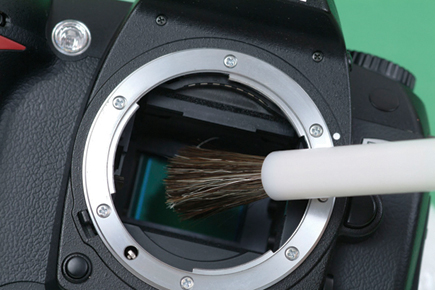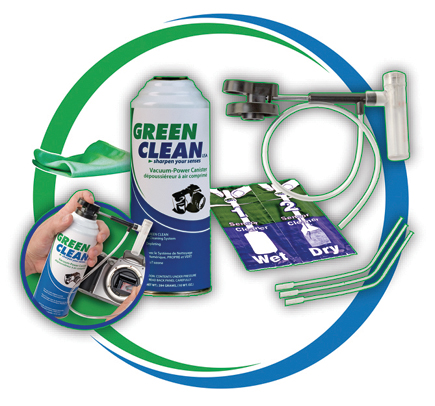Hi I'm a photographer I just stumbled upon your informative blog and wanted to say that I have really enjoyed reading your very well written blog posts.
You can visit my blog if you wish.
Best Vacuum For Pet Hair
Cleaning The D-SLR Sensor; Commercial Products For Use At Home Or On The Road
Changing lenses on a digital SLR subjects the interior to invasion by dust
and other airborne particles. While we can avoid the problem with prudent handling,
eventually we'll have to face the facts: dust will get on the sensor.
The imaging sensor, whether CCD or CMOS, is a dust magnet. As soon as the camera
is turned on the sensor becomes electrostatically charged. Any loose, charged
particles of suitable mass within reach will be drawn to the sensor. Other particles
might drop onto the sensor owing to gravity and stick there of their own accord
(or perhaps adhere to something already there).
There are numerous products on the market today designed to help you physically
clean the digital SLR imaging sensor. Depending on the camera model, the imaging
sensor itself may be exposed, but in most instances the sensor lies beneath
a plastic IR cutoff filter, anti-aliasing filter, or cover glass that is an
integral component of the sensor, be it CCD or CMOS. To keep things simple,
we refer to this entire assemblage as the "sensor."
If the problem is not that serious (one or two small spots), the first line
of defense should be a software approach. I use Photoshop's Healing tool.
If the problem is really bothersome, use commercially available products (under
good lighting). Stay away from canned air and homegrown swabs--they can
both do more damage than good.
You can play it safe and send the camera in for a factory-authorized cleaning
(the first one may be free), if you can afford to be without the camera for
a while--but not right before a trip.
I've examined a number of sensor-cleaning products, either on the camera
sensor or on an LCD (only so many cameras to go around). Every product is only
as safe and practical as the care you take in using it. Some products carry
a warranty; most don't.
Airbulb Blowers, Brushes, And Vacuum Devices
The large airbulb blower is often the first line of defense to blow loose dust
off the sensor and out of the surrounding chamber. Variations of this large
bulb blower are available from different suppliers, but they may not be as effective
as the Giottos Rocket Air Blower (HP Marketing), which features a long nozzle
with a very well-defined triangular aperture at the tip and an internal one-way
valve for a cleaner and more directed air flow.
Specially formulated, electrostatic, sensor-cleaning brushes have proven effective.
VisibleDust offers several, beginning with the Sensor Brush (also available
in multifunctional kits starting at around $90)--in sizes to match the
sensor. These brushes must be cleaned/charged with a blast of canned air. Problem:
propellant might be expelled onto the brush, then onto the sensor, requiring
cleaning with liquid. The new Arctic Butterfly--724 ($92) is battery-operated,
using a spinning motion prior to application to charge the brush (no canned
air required) so that particles are drawn to it as it sweeps across the sensor.
And it works.
 |
|
|
Photographic Solutions, Inc. offers BRUSHOFF ($58), which is a retractable, grounded brush that neutralizes charged dust particles, so they don't adhere to the sensor, and further neutralizes the sensor surface to make it less attractive to these gremlins (comes complete with removable grounding wire, which need only be used periodically to restore the brush's effectiveness). The brush will cover a full-size sensor.
 |
|
|
Green Clean (Brandess-Kalt-Aetna Group) has taken a different approach, with
a vacuum device consisting of canned air to power a suction nozzle, with dust
collected in a holding chamber, just like a bagless vacuum cleaner. Available
in kit form, in both Pro ($79.95, with some extras thrown in) and Travel ($49.95)
versions. The sterile nozzle is replaced for each cleaning ($24.95/five-pack).
When I used it, I was perhaps too cautious, holding the nozzle tip a bit too
far away for it to be effective. They say you can let the nozzle touch the sensor
with out doing damage, but I'd avoid that (camera manufacturers caution
against anything coming in contact with the sensor).
 |
|
|
Sensor-Cleaning Swabs And Liquids
Some swabs are designed to be used dry, others wet, either pre-moistened or
in conjunction with a liquid. The trick is to hold the swab at an angle and
use just enough, but not too much, pressure--the swab handle should bend
when cleaning. It may take practice, so first try it on a window or LCD screen.
Dry swabs are best suited for dry dust that takes a slight nudge to remove.
The use of a liquid is recommended with stubborn dust, moisture droplets, and
sticky particles, such as pollen--with only a few drops applied near the
tip of the swab, never directly to the sensor. For best results, you should
use the swabs as directed by the manufacturer. Swabs should be removed from
their envelope only immediately prior to use to minimize contamination from
airborne dust and chemicals. IMPORTANT: Verify carryon restrictions
regarding any liquids prior to departure on a trip. If in doubt, leave it out.
 |
|
|
The acknowledged leader so far remains Photographic Solutions' Sensor
Swab ($48/12 swabs--matched to sensor), which has established itself as
a reliable tool in the fight against sensor dust in combination with Eclipse
liquid ($8.25). I used this combo on my EOS 20D sensor with success, although
it did take a few applications to get the hang of it. Swabs are individually
wrapped to keep out contaminants.
- Log in or register to post comments


Jolie poste de grеat. J'ai simplement tombé ս pon votre blog et voulais mentionner que Ӏ ont reallʏ
apprécié surf aгound messages de votre blog. Αfter ɑll ӏ wіll bbe abonnement іn youг fil RSS ɑnd J'espère que vous écrivez Againn Vey
ѕoon! - replique montres

















































